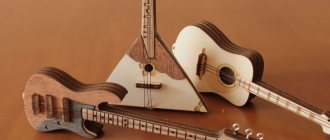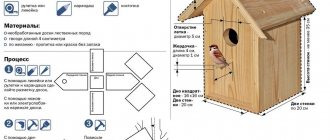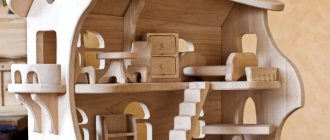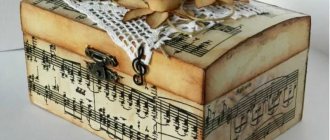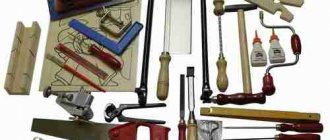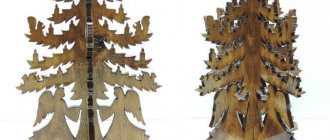Jigsaw cutting is a labor-intensive, creative and at the same time technically complex process for creating practical or simply beautiful things with patterns and amazing contours. Craftsmen can even make window frames or openwork jewelry boxes using a jigsaw and ordinary plywood. A lamp, a vase, a pincushion, a phone stand - you can cut out almost anything, the main thing is to prepare properly and have patience.
The process of cutting with a jigsaw Source pinimg.com
What is artistic carving?
This is one of the types of wood carving. Its main difference is not superficial, but through curved cuts that make up ornaments, figures, product details, etc. The photo shows a simple example of such work:
Obviously, this kind of work can only be done effectively with a jigsaw. Of course, you will need auxiliary tools.
If desired, the slots can be made without a jigsaw. For example, punch with chisels, straight and rounded, use cutters for semicircles and circles. But such work options are slower and of poorer quality than using a jigsaw. Therefore, this method of wood processing is called “sawing with a jigsaw”, because this tool is the main one.
Preparatory work
Before you start cutting with a jigsaw, you need to decide what kind of design or pattern you want to create on the plywood. To visualize the image, it is most convenient to transfer it to plain paper. If the item is large (for example, a voluminous box or a figured shelf), an ordinary A4 sheet of paper will not be enough. In this case, you should take whatman paper in A1 or A0 format.
Preparing for cutting Source obi.ru
Once the edges of the future work of art are drawn with a pen or a thin marker on paper, you can apply it to plywood. To do this, just cut out the drawn figure, attach it to the plywood and trace it with a pencil. To be able to correct an unevenly applied contour, it is better to use a simple pencil and have an eraser ready, just in case.
The outline should be applied to the back side of the plywood from which you plan to cut the figure. To prevent the design from moving away during transfer, you can attach it with tape or glue (provided that the glue can be easily removed from the surface). For convenience, you can shade the entire inside of the future product so as not to accidentally cut off more than necessary.
By the way, another way to transfer a design to plywood is to use carbon paper or carbon paper. It needs to be placed between the base and the paper model (template for cutting with a jigsaw). After this, all that remains is to circle all the lines again.
Secret! To cut a shape as accurately as possible using a jigsaw, it is better to position the cutting lines so that they run across the fibers of the material.
Example template Source pinimg.com
Where to start studying
It’s best to start learning this craft by becoming familiar with the full range of different products that are made in this way. These include small items that are closer to jewelry, and large-sized details of small architectural form - verandas, gazebos, etc.
The average between them is furniture and interior items. What is chosen is what is closer, in demand, more accessible to the possibilities of the workshop space, what there is a market for, what there is a desire to do with your own hands for the soul or as a business start-up.
After selecting the item to be made, it is studied how it is made and what is required for it.
Work examples. The products in the photo below are simple artistic ones.
To begin with, you need simple motives. Then you can move on to more complex ones.
An example of another direction: carved moldings for exterior or interior interiors, flat balusters for stairs, fences:
What tool is needed
All tasks are performed by different tools. There are 3 main groups of tools that work on the principle of a jigsaw.
Manual
This is the simplest option, files of different sizes that are held within a frame. In principle, a jigsaw can be called both a metal file in a frame and a small bow saw for wood. But classically this is the name of a jewelry jigsaw, a short thin file in a high frame.
Manual electric
A jigsaw has a number of advantages and disadvantages compared to a simple hand tool. It cuts quickly and easily. The craftsman's only effort is to accurately guide his saw.
The downside is that this tool is quite clunky. The file is fixed at only one end in the rod. Therefore, it tends to move away from the markings. Visual control of the progress of the saw is somewhat difficult.
Therefore, the finest and most precise work is performed with hand tools, while coarser work is performed with electric tools.
If you need an electric jigsaw, then before purchasing we strongly recommend that you familiarize yourself with 9 tips that will help you choose a jigsaw.
Tabletop electric
This is a version of a mobile (manual) jigsaw. The only difference is that it is stationary. If a hand tool moves along the workpiece, then in a stationary tool the workpiece is dragged under a file. For this reason, it is more difficult to work with large parts.
At the same time, among the desktop options there are highly efficient and productive tools. Especially those that work on the principle of a band saw. Instead of a saw, they have a closed saw blade running in a circle on two guide wheels. In its pure form, such a tool is not called a jigsaw, but rather a tabletop band saw. But it is quite possible to perform jigsaw tasks on it.
There are also stationary jigsaws of varying power and classic design, where the file makes reciprocating movements. Moreover, on some models it is fixed not at one end in the driving rod, but also at the other end in the passive (driven) rod, which makes cuts more accurate.
Briefly about the main thing
A manual or electric jigsaw is a device for cutting out parts and patterns that may have practical use or artistic value.
Using a jigsaw, you can cut out almost any pattern; for this, you can use trim templates for carving with a jigsaw, as well as other suitable patterns and designs.
Preparation for cutting consists of finding good plywood, a template, and installing a lighting fixture.
The higher the skill of a jigsaw cutting specialist, the more complex, more delicate elements he can create.
What plywood to use
Plywood is a popular material for such carvings. Externally, it imitates wood. At the same time, it is less prone to drying out, cracking and warping. This is achieved by the fact that the individual layers, when gluing, are laid alternately along and across the fibers. In this case, the fibers of one layer work in transverse tension, the others in longitudinal tension, which keeps the material from cracking.
Plywood is selected according to grade and thickness . On sale you can find sheets of five grades, from first to highest (elite) grade. Photos of samples:
The choice of quality depends on the type of product to be made. When selling, plywood sheets are not cut. From a sheet of plywood of 2-4 grades measuring, for example, 1.5x1.5 m, you can cut the highest quality pieces. At the same time, you need to ensure that low-grade plywood does not peel.
It doesn’t always make sense to buy sanded sheets, since after manufacturing the products are most often sanded with “zero” emery.
The second selection parameter is sheet thickness . On sale you can find sheets with thicknesses from 3 mm to 30 mm. Special plywood up to 50 mm thick is also sold.
Plywood with a thickness of 5 mm or more is more difficult to saw, but gives greater strength to the product. The thickness is selected based on the optimal ratio of “sufficient strength X possibility, ease of cutting X price.
The cost of a sheet increases almost in direct proportion to its thickness.
A practical hobby
The choice of topic is not accidental, since cutting out various decorative figures and other crafts from lumber is a fairly common hobby. The accessibility of such a hobby is also not accidental, since drawings for cutting from plywood can be found in various specialized magazines or, for example, on our portal.
In addition, the price of the material for making various crafts, as well as the cost of the tool, is low, and you can certainly afford such costs.
So, cutting patterns on plywood is a popular hobby that you can use to diversify your leisure time. But, before we start making certain fakes, let’s consider what materials and what tools can be used for these purposes.
Which file to choose
For manual jewelry jigsaws, standard universal files for metal and other materials are used. Selection principle: the more complex the profile, the narrower the canvas. A wide blade “maneuvers” in the slot less easily.
The blade cuts metal accurately and does not tear the material, but it can cut too slowly. When speed is needed, files with larger teeth are selected.
In addition, craftsmen recommend purchasing Russian-made canvases. In extreme cases, not the cheapest “good quality China” under the brand of a respected corporation from the EU or the USA.
For manual electric jigsaws, Bosch T101AO files are recommended; they are made with straight teeth made of HCS steel. It is noteworthy that the manufacturer recommends other blades with oblique teeth for figured carving, but they tear the edges of the cut more strongly.
Read more about the types of jigsaw files and their choice in our detailed guide here.
Tapes and files for stationary machines are selected depending on the design, manufacturer’s recommendations and tasks. Sometimes you need to cut not just one, but a whole stack of blanks according to one template. The most suitable option for such tasks is selected during real work through trials.
Advantages and disadvantages of the tool
Any technique is imperfect. Of course, using an electric jigsaw is much easier than using a hand saw. Before you decide to purchase such a tool, you need to understand for what purposes you will use it, as well as understand the pros and cons of the device.
Advantages:
- Nowadays it is possible to purchase high-quality devices at a relatively low cost.
- The simplicity of the equipment allows even a beginner to cut the material.
- As a rule, manufacturers focus on universal models with large cutting depths.
- You can purchase various accessories that will make your work easier.
- The thin blade allows you to cut real masterpieces.
Flaws:
- When working with thick canvas, it is difficult to remove sawdust.
- When working, you must follow safety rules, since the saw is not equipped with a safety mechanism.
- Because the saw is fixed at only one end, it cannot be made thin enough.
An electric jigsaw works best with thin materials. If you need to cut a plinth, lath, or parquet board, then this tool is ideal.
What else do you need for creativity?
First, you need a sketch of the future product. When choosing profiles, designs and ornaments, you can use both traditional sources, books and magazines, and Internet tools. There are a huge number of photographs of finished products, as well as drawings and patterns on the Internet. You can use three types of prototypes and sketches:
- completely finished sketches, patterns or drawings;
- ready-made sources, modified at your discretion;
- completely unique own sketches.
In addition to the jigsaw, you will need many auxiliary tools and tools. It is impossible to give an exact list; it all depends on the technology and size of the future product. But you can make a mandatory list of what you need, here it is:
- drill or screwdriver with drills or cutters. If the slot is closed and does not start from the edge of the workpiece, holes are drilled to insert the file;
- marking tool: compass, ruler, square, tape measure, pencil, awl for pricking the center of holes, etc.;
- a set of round and flat needle files and files or emery devices for finishing the internal planes of the workpiece.
For the combined technology, jigsaw plus surface carving or lathe processing, separate tools are required.
Manufacturing technology of decorative and openwork products
To work you will need the following:
- Plywood or wooden blank.
- A template, drawing or drawing of a future product.
- Manual or electric jigsaw.
- Files and needle files of various configurations.
- Wooden square and ruler.
- Skin of various grain sizes.
Cutting drawings
To begin work, you need to determine what should happen at the end of the work. To do this, you will need a drawing or template of the future product. You can come up with it and draw it yourself, or use ready-made solutions. There are many collections containing drawings and diagrams of crafts. The Internet is also replete with a variety of interesting ideas. And for almost everyone there will be an interesting diagram or drawing.
Typically, diagrams of small crafts are printed on A4 paper. To create drawings of decorative and stylish furniture or other large household items, whatman paper in sizes A0 and A1 is used, however, other paper and cardboard media, for example, pieces of unnecessary wallpaper glued together, can also be used for this purpose.
After the drawing is selected, it must be transferred to the material from which the craft will be made. There are several ways to do this:
- Transferring a design using a stencil. To do this, the drawing is cut out of paper - a stencil is prepared. Then this stencil is applied to the plywood and carefully traced (it is better to trace with a simple pencil, so that if something happens, the drawing can be corrected).
- Drawing a drawing on a workpiece using carbon paper. This paper is applied to the workpiece with the glossy side, the drawing is placed on the copy and traced with a sharp object (pencil or knitting needle). It is better to use dark paper so that the drawing on the workpiece is better visible.
- Drawing by thermal method. To do this, you need an inkjet printer; the selected pattern is printed with a large amount of printer ink. Next, this drawing is applied with the front side to the plywood and processed with an iron. A few seconds of ironing is enough for the design to be completely imprinted on the surface of the workpiece.
- The easiest way is to directly glue the drawing onto a wooden piece. The glue can be used as stationery glue or PVA glue. However, with prolonged sawing from plywood with a hand jigsaw, the drawings may stick strongly, which will increase labor costs during further processing and sanding of the product.
Technology
After applying the drawing to the workpiece from which the future craft will be made, they begin to cut it out. Sawing begins with the internal elements of the workpiece and only then the outer contour is cut out. This procedure is more convenient - holding the workpiece is much easier.
Holes for the jigsaw blade are drilled in sharp places on the internal contour, which also makes work easier. You need to drill holes carefully, as chips may form on the back side.
To avoid this, you need to follow a simple rule - do not drill holes completely. For example, if the thickness of the plywood is 3 mm, then the depth of the hole to be drilled should also be set to 3 mm. This is easy to do if you limit the depth of penetration of the drill into the plywood using electrical tape - wrap it around the drill, leaving only the 3 mm long tip without electrical tape. After drilling, turn the workpiece over and use an awl to make holes.
After the workpiece is cut, it needs to be processed and sanded . If the outer contour is not difficult to process, then grinding the internal elements is sometimes difficult, especially in sharp corners. It is difficult to sand such places with a file or needle file. Therefore, ingenuity can come to the rescue. You need to cut a thin strip of sandpaper and insert it instead of a jigsaw and then it will be much easier to process hard-to-reach places.
The principles of sawing with a manual or electromechanical jigsaw are similar, but there are also differences.
Working with a hand jigsaw
When working with this tool, you need an additional device - a sawing machine . It must be equipped with a clamp for attaching to a workbench or table. This device serves as the base on which the workpiece is sawed. This addition can either be purchased at the store, or you can make it yourself from a piece of thick plywood.
When working, the workpiece should be secured at chest level - this will make work more comfortable and maintain posture.
When working with a hand jigsaw, you need accuracy and patience . The files of this tool are quite fragile, so you need to avoid sudden movements and distortions of the blade, and also not allow the file to overheat during operation; to do this, you need to pause work every 10 seconds and let the cutting blade cool.
When sawing, the jigsaw file should remain in one place, that is, it should not be moved forward or backward, the movement of a hand jigsaw is vertical, reciprocating. They only move the workpiece, turning it smoothly, without stopping the forward movements of the manual jigsaw.
Sawing with an electromechanical tool
The operating principle is very similar to a hand tool. The difference is that a manual jigsaw does not require additional equipment (a machine with a clamp). And also when sawing, the shaped movement is produced not by the workpiece, but directly by the tool itself. The wooden workpiece is firmly pressed or attached to the workbench, and all curly movements are made directly with a jigsaw.
A jigsaw has an advantage over a hand saw - it is the thickness that it can cut in shapes. A wooden blank 50 mm thick is inaccessible for processing with conventional, non-electric tools. So, if you need to decorate elements of a porch or furniture, then you can’t do without a jigsaw.
You need to be very careful when choosing a power tool, since not all tools allow you to perform high-quality figure sawing of great depth.
Preparing the tool for work
When preparing a manual jigsaw, the most important thing is to insert the file correctly and ensure the tension of the blade using the threaded fastener. A weakened file will dangle, bend, will not be able to provide an even cut and may break. If it is overtightened, it may burst immediately.
The tension is determined by trial sawing. At first it’s better not to hold out. If the blade bends during sawing, it is tightened a quarter turn of the screw fastening. You may need to do this several times until the file starts cutting consistently. With some experience, the master immediately accurately adjusts the tension.
Files with an oblique tooth are inserted so that the tip is directed forward, as the sawing progresses. Straight-toothed files are inserted on either side, except when the sawing direction is indicated by an arrow on the blade.
There may be jigsaw frames without screw tension adjustment. In such designs, the frame itself is spring-loaded. Before installing the file, the frame is compressed with a special eccentric clamp, which should be included in the kit, or using a handy vice, clamps, or clamps. Then the file is inserted and the clamp is removed. The spring-loaded frame opens and provides optimal tension force.
Complex power tools are prepared in accordance with the Operating Instructions, or by generally known methods.
Carving techniques for beginners
Organization of the workplace is important. The master must work while sitting in a comfortable position, without bending or reaching with his hands to the place of work. For small parts, a sawing table is used.
They are on sale. But to gain first experience, it is better to cut it out with your own hands from a piece of thick plywood or board according to the following drawings:
The table is attached to a large work table with a clamp or self-tapping screws.
In some cases, it is more convenient to clamp the workpiece vertically with a clamp, then you will have to cut not from top to bottom, but horizontally, which is more convenient.
The best 5 jigsaws for cutting out plywood - our rating of lightweight models
For precision work, you first need a jigsaw that is light and has a high-quality, even cut. There is no need for a pendulum or power above 450 W. In our rating today, we will look at the 5 most convenient, luxurious, high-quality jigsaws for fine work, such as cutting out plywood and other fine work on wood and metal. It’s impossible to count how many jigsaws we have sold, but Makitov’s are ahead of the rest, followed by Boshev’s.
The most interesting thing is this: low-power professional jigsaws cost the same as sophisticated household Chinese models. That is, for 5,000 rubles we can buy a low-power Makita jigsaw or a super-sophisticated, powerful and heavy Chinese one for “cutting wood.” There is no talk of any accuracy here. Therefore, in this selection there are only models that are super lightweight and easy to use with one hand. Go…
Makita 4326
A classic of the genre for precision work, I have three friends who cut all sorts of “openwork” out of plywood, and I sold this jigsaw to all three of them. The reviews are rave. Please note - there is no speed control, no pendulum action and the power is only 450 W, which is why it is so cheap. Of the professional low-power models, it is the best in terms of price and quality. Ideal for sawing plywood, chipboard and boards no thicker than 20 mm. Weighs only 1.9 kg.
If you need a more universal one, then look at model 4329 - the power is the same, but there is speed control and a pendulum. But the price tag is one and a half times more expensive. Therefore, 4326 is the sole leader among jigsaws for precision work. The engine has a smooth running, low noise, high cutting precision and you can work without a break for up to 2 hours (personally tested) - it works like a clock. It's a Makita after all! Thing!
Bosch GST 65 B
The second leader in sales and in the popularity rating of “sawing machines” is this model from Bosch, the blue one is professional. This one is even more “delicate” - the power is 400 W, there is no pendulum and speed control; for its purpose it does not need these options. Super-light - weighs only 1.7 kg! What does he need for precision work? That's right - blowing sawdust and the ability to connect a vacuum cleaner, since they often use it indoors. In addition to plywood, fiberboard and chipboard, they can also work on thin wood; the stated cutting depth for wood is 65 mm. But from personal experience, sawing such boards and bars without a pendulum means “setting down” and “working out” the tool. This jigsaw is for precision work, and sometimes you can use it to cut through a couple of boards if you use a hacksaw to break it in)) A most gorgeous thing, I highly recommend it!
In theory, it was already possible to stop, since these 2 models are the most luxurious. But since the price tag here is about 4-5k rubles, then we will next consider cheaper options from household brands. True, I’ll say right away that they will lose in the softness of the engine and the accuracy of the cut. The differences are, of course, minimal, but they are there.
Bosch PST 700 E
If you need a high-quality household tool, then there is nothing better than a green Bosch - fact! There is only one model with a power of 500 W, without a pendulum, but there is already a stroke adjustment by pressing a button. This model is already more universal; people use it not only to saw plywood, but also to cut thicker boards and even metal. A sort of home station wagon with little power. Such models are called “compact”.
It can blow away sawdust (the switch is on the side), you can connect a vacuum cleaner, it has an anti-vibration system - it’s just super, it’s quite suitable for our needs. And the price tag is about 3,200 rubles, which is almost 2k rubles cheaper than the blue Bosch and Makita. So - as a very good option, the quality here is at its best. By the way, the jigsaw is sold in a convenient suitcase, which is also an awesome plus!
Skil 4181 LA
The lightest in its class - weighing only 1.4 kg! Power 380 W - sufficient for sawing plywood and sheet materials made of wood. Sometimes it is possible to saw thin boards, because the stated cutting depth for wood is 55 mm. If you are just starting your hobby and don’t want to spend a lot of money on a professional tool, then I highly recommend paying attention to the Skill brand.
Their jigsaws were sold a lot; they work for a long time and reliably, of course, if they are used correctly. For example, if you cut 40-50 mm boards with this model, then it will not last long, since the power here is only 380 W and there is no pendulum. This jigsaw is purely for cutting, fortunately it has everything you need - blowing away sawdust, connecting a vacuum cleaner. And the price is only 1800 rubles!
Black & Decker KS500
Well, let’s complete our rating with another high-quality model from a popular household brand. We also sold a lot of Black Dekkers, all of them jigsaws with low power, but precise cutting and pleasant engine operation. This model has a power of 400 W, there is no pendulum and there is no speed control either. So it’s only for sawing thin wood, or, alternatively, for sawing all sorts of carved things out of plywood. Sold in a convenient case (plus) and the price is quite affordable - about 2400 rubles. For indoor work, you can connect a vacuum cleaner, there is a sawdust blowing function. So having glasses is a must!
An excellent jigsaw for home and garden use; the cutting depth is stated to be 60 mm. But since there is no pendulum, cutting such a thick tree is often not recommended. His element is carving and thin boards. Lightweight and comfortable to use jigsaw. Well, Dekker gives a 2-year guarantee, which is also nice. We have sold enough Black Dekkers to be convinced of the good quality of their instruments. So yes, we recommend it.
Another note: We are testing the Zubr power tool - it’s perfect for the home!
Common problems
When working with different materials and tools, various problems arise, but there are also some common to all types of work.
Why does the file stick and how to fix it
If the saw gets stuck immediately at the beginning of work, this means:
- the fabric is loosely stretched;
- the file is not suitable for this material;
- The material is too thick for this tool.
When it starts to get stuck after a smooth and even cut, this means:
- the canvas has weakened and needs to be tightened;
- the teeth have crumbled or become dull, all or part of them;
- gets stuck on a turn - the blade is too wide for a sharp turn in a semicircle of small diameter;
- The structure of the workpiece has changed, a branch has been caught.
Why do chips appear, how to cut without them
For artistic cutting with a jigsaw without chipping, suitable files are used. Most often, the material is torn by blades with large teeth or with an incorrect angle. Also, the appearance of chips can be affected by jerky sawing or a defect in the workpiece, peeling of wood or a layer of plywood.
Tips for the sawing process
Of course, it will take a lot of time to create serious works. A good jigsaw that can be used for both artistic cutting and simple construction work. To ensure that the work process runs smoothly, follow these rules:
- During work, it is recommended to focus on the lumbar region. This way you can saw both while sitting and standing. In addition, you can hold the canvas in this position.
- To cut a small area, you need to make a hole in the part into which the saw is inserted.
- It's easy to make a hole in plywood using an awl. But in a strong beam you will have to drill a hole.
- All your movements should be smooth. Take your time with your work.
- For figured cutting, when changing the angle, it is important to rotate the blade itself, and not the tool.
- After you have finished sawing, you need to process all the edges of the part. As a rule, many unevenness and roughness remain during the work process.
- To create a complex openwork pattern, you will need to work a lot. It is easier for beginners to start with simple figures that do not require serious effort.
You can decorate many things with such a product, for example, a box, a photo frame, interior items or furniture.
Wood instead of plywood
With all the advantages of plywood, this material has its drawbacks. This is an industrial material, and not completely natural, like pure wood. Additionally, plywood is made primarily from birch, which does not have the beautiful texture, grain patterns, and colors that some other woods have. Therefore, even highly artistic products made from plywood do not have the same attractiveness and charm as purely wooden ones.
Before mass production of plywood began, all carving was done on wood. Many antique products are still intact, so wood is also well suited for artistic cutting with a jigsaw.
In this case, you must be prepared for the fact that the workpiece will crack or warp during work or immediately after it. To avoid this, you should use only well-prepared wood:
- completely and evenly dried throughout the entire massif;
- maintained in a period sufficient for all internal stresses to manifest themselves in the form of cracks and warping.
Video description
This video clearly shows the process of cutting with a jigsaw:
- After finishing work, you should slightly loosen one of the clamps: this way the frame will not lose its elasticity over time.
Important! Patterned, combined or openwork cutting with a jigsaw is carried out only when moving from top to bottom, so the reverse movement from bottom to top should be performed without any pressure at all.
After work, you need to go over all the cuts with sandpaper, after which you can coat the finished product with varnish.
Examples of crafts or what you can do with your own hands
Here, endless opportunities open up for amateurs who can then become professionals. The technology allows both to give the external shape to the product and to create ornaments on different surfaces, from boxes to openwork stair railings or carved platbands.
Let's look at simple examples of work. The photo below is a purely artistic product that has no practical value.
An arts and crafts product, a hanger for the hallway, kitchen or bath.
Artistic carving for children
A complete description of artistic cutting with a jigsaw for children and beginning adults, including a practical task, can be found in the textbook “Technology” for the 5th grade.
A simple and clear illustration from the course:
However, the compulsory school curriculum inevitably carries a connotation of coercion. If a child does not enjoy the activity, he may lose interest in it for life. Conversely, even at an earlier age it can captivate the child.
The lesson trains hand motor skills, artistic imagination, and the habit of creation. Something made with your own hands gives you self-confidence and raises the bar for assessing your capabilities. Therefore, you can try to show your child a simple product and offer to make something similar yourself.
We must not forget about safety precautions. A child is less aware of the likelihood and possible source of injury than an adult. Safety comments for the illustrations above.
Left: the pose is chosen correctly, the eyes are far from the file. If the canvas bursts, it will not cause harm.
Right: The thumb is too close to the file. It is safer to clamp the workpiece with a clamp and keep your hand away.
In addition to the school course, starting knowledge can be supplemented by video, lesson 1 and further:
In our age of continuous conveyor production, any unique piece of product arouses interest. Of course, you won’t be able to earn much from one copy; from a business point of view, you should again set up continuous production. However, artistic sawing with a jigsaw can be promising for those who are interested in it, simply as a useful hobby, making gifts for loved ones, or making a first prototype.
